Big Bang from a Very Productive Region (January 20, 2005)
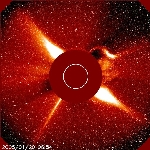 |
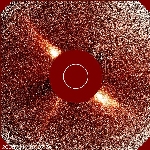 |
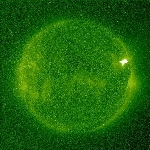 |
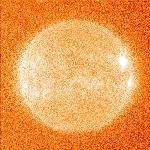 |
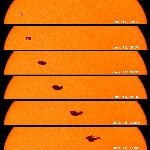 |
C2 Movies: |
EIT 195 Movies: |
Hi-Res: TIF (8.1M) |
||
|
Active region NOAA 10720 has turned out to be one of the most flaring regions of the last few years, with 15 M-class and 5 X-class events since 14 January. The biggest flare so far came early on 20 January, an X7.1 that peaked at 7UT (2am EST). Even before the peak of the flare, energetic protons were pummeling SOHO as well as other spacecraft. The particles show up as a "snow storm" in the LASCO and EIT images as they crash into the detectors and deposit part of their energy. The SOHO spacecraft experienced minor glitches that could be fixed by ground controllers, thanks to a clever software upgrade that was performed in 1999. Without this upgrade, SOHO would have been thrown into a spacecraft emergency due to the loss of its guide star. With the improved software, several stars are tracked at the same time, and losing the primary one is no big deal as long as there are more stars left to track. During the first few hours of the storm, four stars were lost. Still, two of SOHO's instruments (CDS and UVCS) were manually put in safe mode by turning down high voltages, to avoid negative effects of the bombardement. The energetic proton event was the 5th to hit the 'red zone' on the SOHO CELIAS flare page. The total flux was a bit smaller than the previous four and was decaying more rapidly. However, based on the flux level of the highest energy protons (> 100 MeV), this radiation storm was the strongest since October 1989, according to NOAA SEC. A rare, strong ground-level event (GLE) was also observed. GLEs are increases in the ground-level neutrons detected by neutron monitors and are generally associated with very high energy protons (>500 MeV). Elevated neutrons at ground level means there are high fluxes of energetic protons near Earth. High energy radiation storms can be particularly hazardous to spacecraft, and to communication, navigation, and aviation operations at high latitudes. The shock driven by the CME arrived at Earth around 17 UT on January 21, causing a severe geomagnetic storm (Kp = 8). Spectacular auroras were reported in many Nothern European countries. Scientists are still debating whether the energetic particles from such events are accelerated by the flare itself, by the shock front of an associated coronal mass ejection, or both. |


